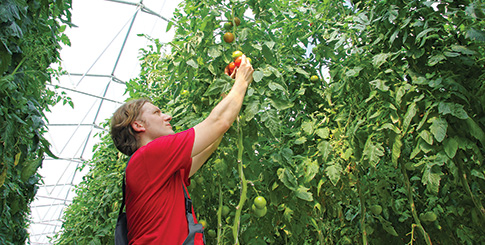The Leamington Advantage
As an early entrant to greenhouses in North America, Leamington began its growing odyssey in the late 1970s and early 1980s, according to Wowryk. “There’s a lot of history,” he says, as well as industry firsts with “technology that has been introduced and evolved through the Leamington area.” Growers in the region truly have it down to a science—with the right climate, the right location, and plenty of experience and leadership to back them up.
The clustering of older and newer greenhouses in the region provides a base of experience, knowledge, and marketing élan to the sector. In response, manufacturers and suppliers catering to the industry have set up shop too, and a wealth of expertise and advice can be gleaned from the nearby Harrow Research Station as well.
Add three major terminal markets (the Ontario Food Terminal in Toronto and two markets in nearby Detroit, Michigan), as well as plentiful transportation options, and Leamington is rightfully a mecca for greenhouse-grown product.
One might classify the rising minimum wage in Canada as a drawback to greenhouse production cost ratios, but Ontario’s pay has tended to be higher than other provinces anyway. This in itself is not a major threat as much of the process is automated, with a move toward more in the near future.
Although it is expensive to invest in high-tech automation, the investment is likely to be repaid as labor costs rise and worker availability falls. “Without adequate offshore labor programs and with a lack of farming labor, growers are looking at all aspects of the operation—whether it’s growing, harvesting, or packing—that they can automate to minimize overhead costs,” observes Wowryk.
Investment & Returns
Although the rewards are plentiful, the initial investment to set up a greenhouse operation can be rather steep, serving as another deterrent. According to Khosla, depending on the type of greenhouse, the initial investment can range from about C$750,000 to C$1 million per acre.
Another factor affecting profit and loss is legislation by the Ontario provincial government to help reduce greenhouse gas emissions. “The cap-and-trade program has slightly increased the cost of energy for growers,” admits Khosla. “So now growers have to be more efficient to make that manageable.”
Leamington’s own climate means growers must manage significant temperature variability in winter and summer months. To help deal with seasonal highs and lows and ensure cost-effective availability and delivery of product all year, a number of growers are venturing out of the area and scouting new locations in the United States, Mexico, and Central and South America.



